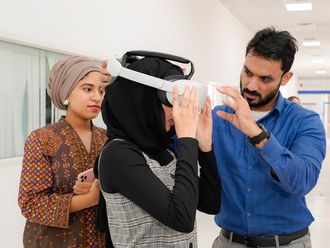Dubai: When it comes to disorders affecting nights of peaceful sleep, sleep apnoea ranks on top with an estimated 936 million people worldwide suffering from the condition, a latest study has suggested.
Sleep apnoea is a chronic sleep-disordered breathing condition associated with increased risk of mortality and reduced quality of life.
The statistics are based on the latest scoring rules for determining one’s apnoea — hypopnea index (AASM 2012) and are connected with a 16-country study announced in May 2018. According to Business Wire-Aetoswire, the statistics were presented by ResMed this September at the European Respiratory Society’s annual ERS Congress in Paris.
They also revealed that roughly 175 million Europeans have obstructive sleep apnoea (OSA), and around 90 million Europeans have moderate to severe sleep apnoea, meaning they experience at least 15 breathing events an hour during sleep.
The new global prevalence is nearly tenfold higher than the previous one — 100 million — estimated by the World Health Organisation in 2007. This highlights the scale of a global health crisis, and UAE residents are no exception to the condition.
Sleep apnoea in UAE
“On the whole, less than half a million people suffer from sleep aponea in the UAE,” he told Gulf News.
The condition can occur in people of all ages not only as a result of genetic and anatomical predisposition, but also due to morbid obesity, said Dr Facchini.
“There are two age groups, which show an increased prevalence — one is in young people, when the tonsils obstruct the oropharyngeal space, and the second is in those above the age of 50, when their pharyngeal and laryngeal muscles become more ‘floppy’ at night,” he explained.
Generally, people at a very young age do not have episodes of apnoea/hypoapnoeas. However, Dr facchini pointed out it is physiological to present few episodes per hour as a person gets older.
“It is normal to expect up to 10 episodes per hour in a person who has reached the age of 80,” he said.
Many factors can contribute to the occurrence of an abnormal number of episodes including smoking, alcohol consumption, and the use of sedatives, which increases muscle relaxation of the upper airways.
“Hypertrophic tonsils, obesity and other health conditions reduce the available space in the upper airways, making it more likely to present obstructive sleep apnoea,” added Dr Facchini.
The symptoms of the condition can include loud snoring, breathing pauses, chocking or gasping for air, insomnia with restless sleep, and the frequent need to go to toilet during the night.
Symptoms can also occur during the daytime in the form of early morning headaches, waking up with a dry mouth, daytime sleepiness, irritability and poor capacity of concentration, and can include the risk of falling asleep during routine activities, explained Dr Facchini.
“Obstructive sleep apnoea is not only a concern for the symptoms it causes, but more for the long term health consequences it exposes untreated patients to such as increased risk of car accident, increased risk of developing high blood pressure, diabetes, heart failure and stroke,” he said.
The study’s purpose was to estimate the prevalence of symptoms and risk of OSA in the primary health care setting in Dubai, as well as the relationship between obesity and sleep apnoea.
“The results showed that the condition gets worse with ageing and goes up to 40 per cent after the age of 50,” said Dr Hariri.
He pointed out that an adult is diagnosed with the condition when he experiences five events where he stops breathing or experiences shallow breathing.
Meanwhile, in children, experiencing one or two breathing pauses is considered abnormal.
Symptoms
■ Loud snoring
■ Breathing pauses, choking or gasping for air
■ Insomnia, or fitful sleep
■ Frequent need to go to the toilet
■ Early morning headaches
■ Waking up with a dry mouth
■ Daytime sleepiness, irritability and poor capacity of concentration
Consequences
■ Increased risk of high blood pressure
■ Diabetes
■ Heart failure
■ Stroke
How to sleep well
1. Try to maintain a regular sleep during the days of the week and during weekends as irregular habits may cause an imbalance in the “biological clock” in the brain.
2. Try not to sleep for more than eight hours, as it can adversely affect the sleep-wake system, and may lead to general fatigue during the day
3. Exercise regularly to improve your health, protect you from obesity, and help you sleep at night
4. Avoid taking a nap in the late afternoon or evening. If you want to nap, try to take it in the early afternoon for no longer than 30 minutes
5. Avoid stimulants such as caffeine found in coffee, cola and chocolate
6. Avoid smoking before bedtime
7. Avoid eating large heavy meals or excessive fluids before bedtime
Source: Dr Hassan Hariri, Head of Sleep Clinic and Pulmonologist at Rashid Hospital
Facts and figures:
At-risk patients of sleep apnoea can have another related chronic medical condition:
■ 83% of people with drug-resistant hypertension have sleep apnoea
■ 77% of people with obesity
■ 76% of people with chronic heart failure
■ 72% of people with type 2 diabetes
■ 62% of people with a prior stroke
■ 49% of people with atrial fibrillation
Source: Dr. Adam Benjafield, lead researcher and ResMed’s vice president of Medical Affairs on BUSINESS WIRE/AETOSWire













